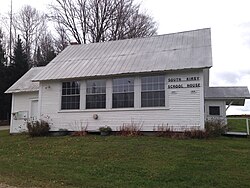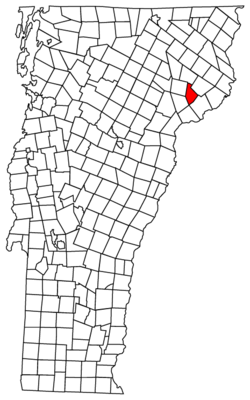Kirby is a town in Caledonia County, Vermont, United States. The population was 575 at the 2020 census.[3]
Kirby, Vermont | |
|---|---|
 South Kirby School House | |
 Kirby, Vermont | |
| Coordinates: 44°31′N 71°56′W / 44.517°N 71.933°W | |
| Country | United States |
| State | Vermont |
| County | Caledonia |
| Area | |
| • Total | 24.4 sq mi (63.2 km2) |
| • Land | 24.4 sq mi (63.1 km2) |
| • Water | 0.04 sq mi (0.1 km2) |
| Elevation | 1,558 ft (475 m) |
| Population (2020) | |
| • Total | 575 |
| • Density | 24/sq mi (9.1/km2) |
| Time zone | UTC-5 (Eastern (EST)) |
| • Summer (DST) | UTC-4 (EDT) |
| ZIP code | 05824 |
| Area code | 802 |
| FIPS code | 50-37900[1] |
| GNIS feature ID | 1462130[2] |
History
editThe town was chartered to Roswell Hopkins in 1790; Hopkins served as Clerk of the House of Representatives and Secretary of State of Vermont, and he accepted the land grant in lieu of cash as payment for his government service.[4] The grant Hopkins received was originally called Hopkinsville; it was later combined with a parcel from the town of Burke, and renamed Kirby.[5] Several ideas have been proposed for how the name Kirby was chosen; the most common is that it is a variant of the English Kirkby, which means a village or settlement around a church.[6][7] By the time the town was organized in 1807, Hopkins had sold his interest and moved to Hopkinton, New York.[5]
Geography
editKirby is located on the eastern border of Caledonia County in northeastern Vermont. It is bordered by the town of St. Johnsbury to the southwest, Lyndon to the west, Burke to the north, Victory to the northeast, Concord to the southeast, and Waterford to the south. According to the United States Census Bureau, the town has a total area of 24.4 square miles (63.2 km2), of which 24.4 square miles (63.1 km2) is land and 0.04 square miles (0.1 km2), or 0.20%, is water.[8]
U.S. Route 2 passes through the southern corner of the town, connecting St. Johnsbury to the west with Lancaster, New Hampshire, to the east.
The highest point in Kirby is the 2,750-foot (840 m) summit of Kirby Mountain, located along the town boundary with Victory.[9]
Demographics
edit| Census | Pop. | Note | %± |
|---|---|---|---|
| 1800 | 20 | — | |
| 1810 | 311 | 1,455.0% | |
| 1820 | 312 | 0.3% | |
| 1830 | 401 | 28.5% | |
| 1840 | 520 | 29.7% | |
| 1850 | 509 | −2.1% | |
| 1860 | 473 | −7.1% | |
| 1870 | 417 | −11.8% | |
| 1880 | 398 | −4.6% | |
| 1890 | 355 | −10.8% | |
| 1900 | 350 | −1.4% | |
| 1910 | 297 | −15.1% | |
| 1920 | 324 | 9.1% | |
| 1930 | 311 | −4.0% | |
| 1940 | 252 | −19.0% | |
| 1950 | 257 | 2.0% | |
| 1960 | 235 | −8.6% | |
| 1970 | 224 | −4.7% | |
| 1980 | 282 | 25.9% | |
| 1990 | 347 | 23.0% | |
| 2000 | 456 | 31.4% | |
| 2010 | 493 | 8.1% | |
| 2020 | 575 | 16.6% | |
| U.S. Decennial Census[10] | |||
As of the census[1] of 2000, there were 456 people, 168 households, and 122 families residing in the town. The population density was 18.7 people per square mile (7.2/km2). There were 207 housing units at an average density of 8.5 per square mile (3.3/km2). The racial makeup of the town was 96.05% White, 0.44% African American, 0.44% from other races, and 3.07% from two or more races. Hispanic or Latino of any race were 1.54% of the population.
There were 168 households, out of which 36.9% had children under the age of 18 living with them, 56.0% were married couples living together, 9.5% had a female householder with no husband present, and 26.8% were non-families. 19.0% of all households were made up of individuals, and 4.8% had someone living alone who was 65 years of age or older. The average household size was 2.71 and the average family size was 3.05.
In the town, the population was spread out, with 28.9% under the age of 18, 5.5% from 18 to 24, 28.3% from 25 to 44, 28.5% from 45 to 64, and 8.8% who were 65 years of age or older. The median age was 37 years. For every 100 females, there were 99.1 males. For every 100 females age 18 and over, there were 98.8 males.
The median income for a household in the town was $37,917, and the median income for a family was $43,333. Males had a median income of $27,778 versus $22,500 for females. The per capita income for the town was $16,675. About 15.2% of families and 15.3% of the population were below the poverty line, including 22.0% of those under age 18 and 12.8% of those age 65 or over.
Notable people
edit- William W. Grout, US Congressman
- John McClaughry, member of the Vermont House of Representatives and Vermont Senate, Republican nominee for Governor of Vermont in 1992.
- Moriah Wilson, cyclist and murder victim
References
edit- ^ a b "U.S. Census website". United States Census Bureau. Retrieved January 31, 2008.
- ^ "US Board on Geographic Names". United States Geological Survey. October 25, 2007. Retrieved January 31, 2008.
- ^ "Census - Geography Profile: Kirby town, Caledonia County, Vermont". United States Census Bureau. Retrieved December 31, 2021.
- ^ Grand Lodge of Vermont (1879). Records of the Grand Lodge of Free and Accepted Masons of the State of Vermont, 1794-1846. Burlington, VT: Free Press Association. pp. 32–34.
- ^ a b Records of the Grand Lodge of Vermont.
- ^ Capace, Nancy (2000). Encyclopedia of Vermont. Santa Barbara, CA: Somerset Publishers. p. 329. ISBN 978-0-403-09602-2.
- ^ Bardsley, Charles Wareing Endell (1901). A Dictionary of English and Welsh Surnames. New York, NY: Oxford University Press. p. 455. ISBN 9785871144015.
- ^ "Geographic Identifiers: 2010 Demographic Profile Data (G001): Kirby town, Caledonia County, Vermont". U.S. Census Bureau, American Factfinder. Archived from the original on February 12, 2020. Retrieved February 6, 2013.
- ^ U.S. Geological Survey Burke Mountain, VT 7.5-minute quadrangle, 1988.
- ^ "U.S. Decennial Census". United States Census Bureau. Retrieved May 16, 2015.
